Financial Crime and Data Analytics
VerifiedAdded on 2020/03/01
|10
|1832
|104
AI Summary
This assignment delves into the crucial role of data analytics in combating financial crime, focusing on the Financial Crimes Enforcement Network (FinCEN). It examines the challenges FinCEN faces due to inconsistent data quality and limited IT capabilities, highlighting the need for advanced analytics and infrastructure upgrades. The analysis emphasizes how effective data analytics enables FinCEN to identify patterns and relationships within vast datasets, facilitating the detection of illicit activities, terrorist financing, and money laundering. The assignment underscores the importance of data-driven intelligence for national security.
Contribute Materials
Your contribution can guide someone’s learning journey. Share your
documents today.
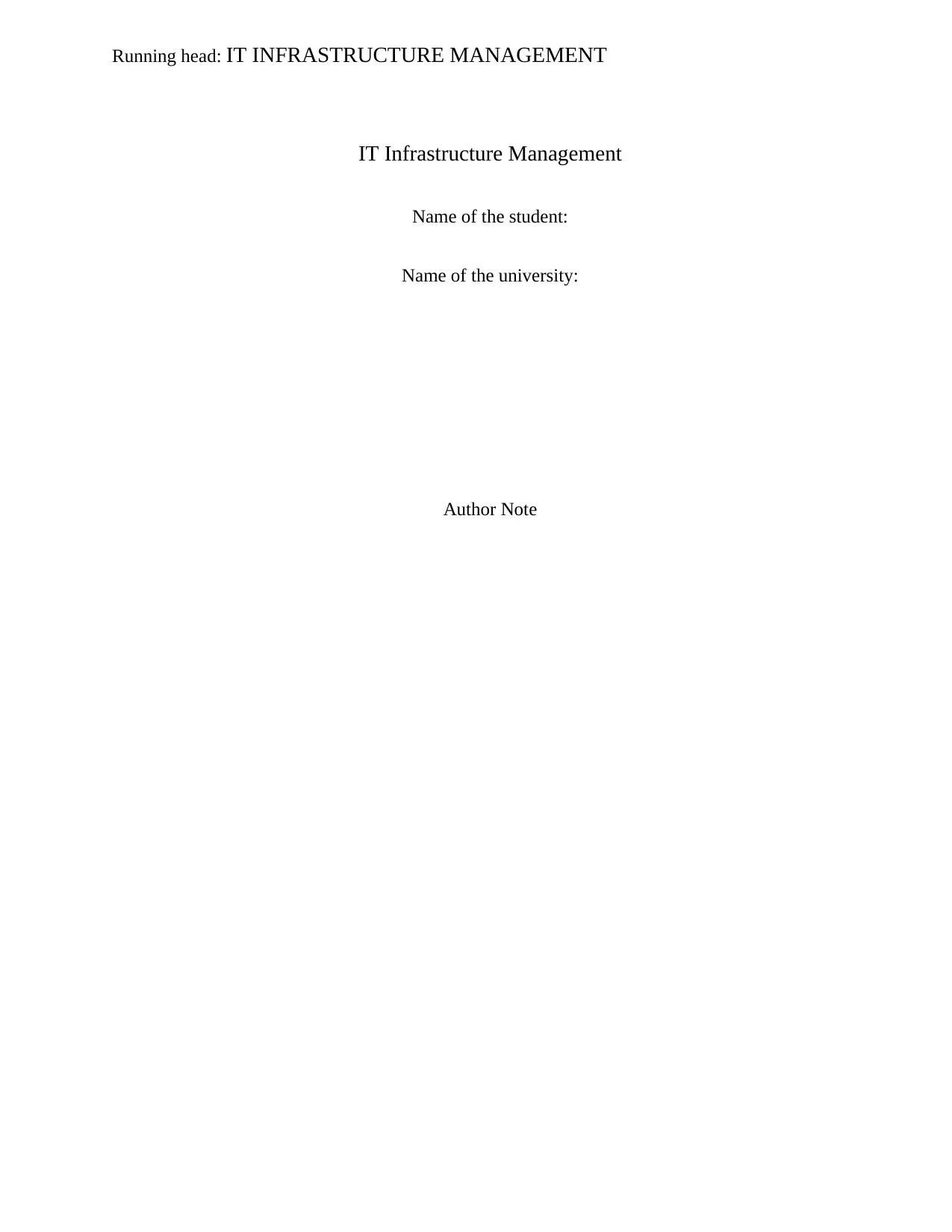
Running head: IT INFRASTRUCTURE MANAGEMENT
IT Infrastructure Management
Name of the student:
Name of the university:
Author Note
IT Infrastructure Management
Name of the student:
Name of the university:
Author Note
Secure Best Marks with AI Grader
Need help grading? Try our AI Grader for instant feedback on your assignments.
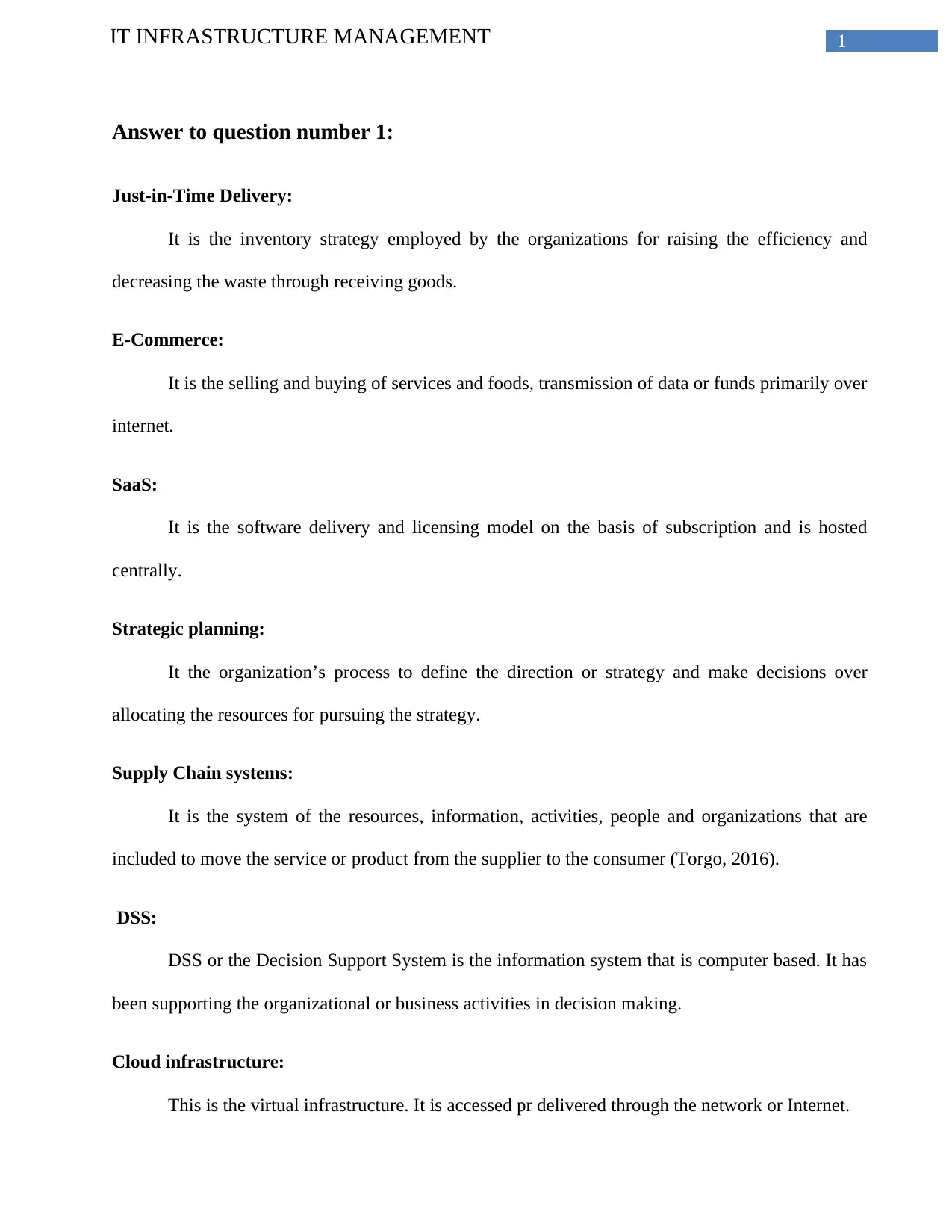
1IT INFRASTRUCTURE MANAGEMENT
Answer to question number 1:
Just-in-Time Delivery:
It is the inventory strategy employed by the organizations for raising the efficiency and
decreasing the waste through receiving goods.
E-Commerce:
It is the selling and buying of services and foods, transmission of data or funds primarily over
internet.
SaaS:
It is the software delivery and licensing model on the basis of subscription and is hosted
centrally.
Strategic planning:
It the organization’s process to define the direction or strategy and make decisions over
allocating the resources for pursuing the strategy.
Supply Chain systems:
It is the system of the resources, information, activities, people and organizations that are
included to move the service or product from the supplier to the consumer (Torgo, 2016).
DSS:
DSS or the Decision Support System is the information system that is computer based. It has
been supporting the organizational or business activities in decision making.
Cloud infrastructure:
This is the virtual infrastructure. It is accessed pr delivered through the network or Internet.
Answer to question number 1:
Just-in-Time Delivery:
It is the inventory strategy employed by the organizations for raising the efficiency and
decreasing the waste through receiving goods.
E-Commerce:
It is the selling and buying of services and foods, transmission of data or funds primarily over
internet.
SaaS:
It is the software delivery and licensing model on the basis of subscription and is hosted
centrally.
Strategic planning:
It the organization’s process to define the direction or strategy and make decisions over
allocating the resources for pursuing the strategy.
Supply Chain systems:
It is the system of the resources, information, activities, people and organizations that are
included to move the service or product from the supplier to the consumer (Torgo, 2016).
DSS:
DSS or the Decision Support System is the information system that is computer based. It has
been supporting the organizational or business activities in decision making.
Cloud infrastructure:
This is the virtual infrastructure. It is accessed pr delivered through the network or Internet.
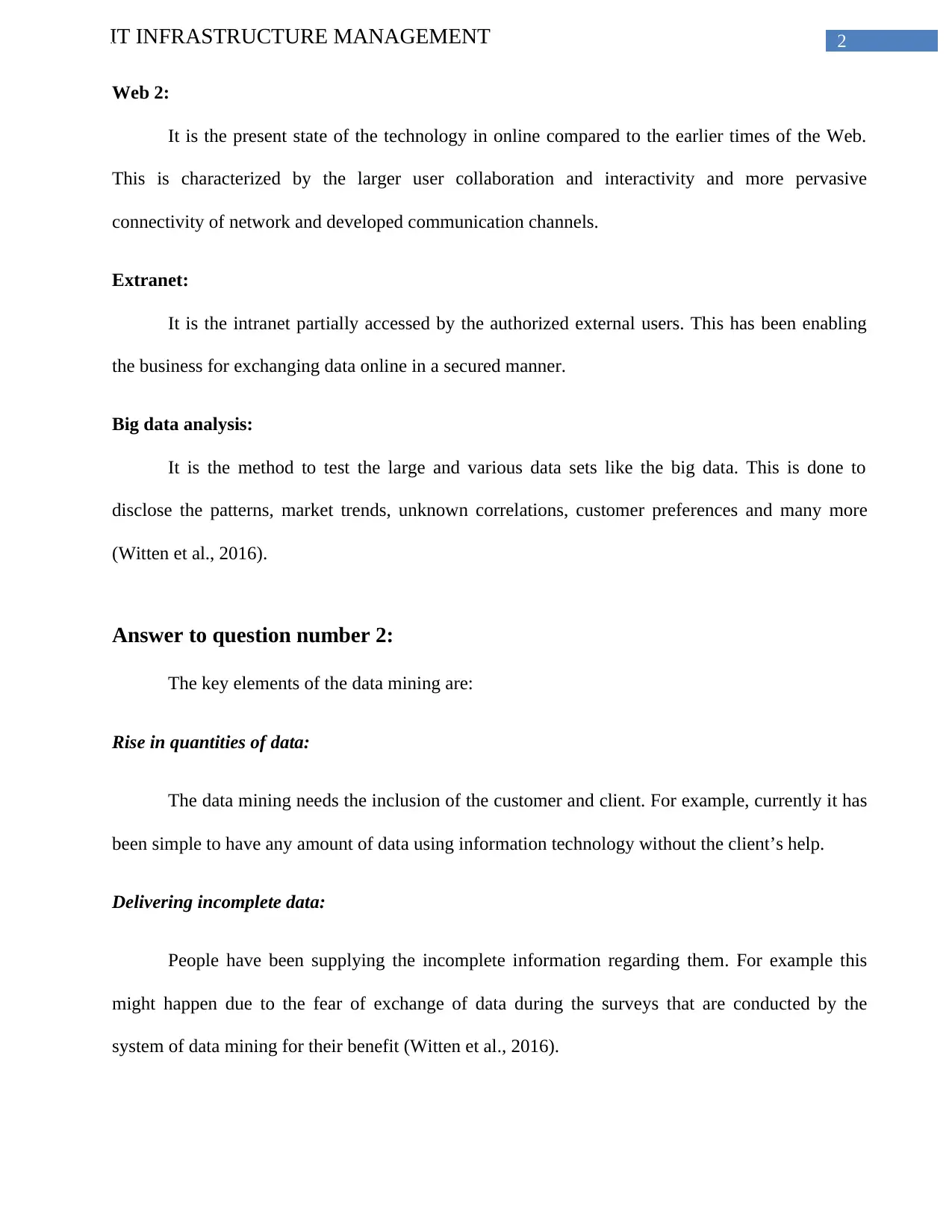
2IT INFRASTRUCTURE MANAGEMENT
Web 2:
It is the present state of the technology in online compared to the earlier times of the Web.
This is characterized by the larger user collaboration and interactivity and more pervasive
connectivity of network and developed communication channels.
Extranet:
It is the intranet partially accessed by the authorized external users. This has been enabling
the business for exchanging data online in a secured manner.
Big data analysis:
It is the method to test the large and various data sets like the big data. This is done to
disclose the patterns, market trends, unknown correlations, customer preferences and many more
(Witten et al., 2016).
Answer to question number 2:
The key elements of the data mining are:
Rise in quantities of data:
The data mining needs the inclusion of the customer and client. For example, currently it has
been simple to have any amount of data using information technology without the client’s help.
Delivering incomplete data:
People have been supplying the incomplete information regarding them. For example this
might happen due to the fear of exchange of data during the surveys that are conducted by the
system of data mining for their benefit (Witten et al., 2016).
Web 2:
It is the present state of the technology in online compared to the earlier times of the Web.
This is characterized by the larger user collaboration and interactivity and more pervasive
connectivity of network and developed communication channels.
Extranet:
It is the intranet partially accessed by the authorized external users. This has been enabling
the business for exchanging data online in a secured manner.
Big data analysis:
It is the method to test the large and various data sets like the big data. This is done to
disclose the patterns, market trends, unknown correlations, customer preferences and many more
(Witten et al., 2016).
Answer to question number 2:
The key elements of the data mining are:
Rise in quantities of data:
The data mining needs the inclusion of the customer and client. For example, currently it has
been simple to have any amount of data using information technology without the client’s help.
Delivering incomplete data:
People have been supplying the incomplete information regarding them. For example this
might happen due to the fear of exchange of data during the surveys that are conducted by the
system of data mining for their benefit (Witten et al., 2016).
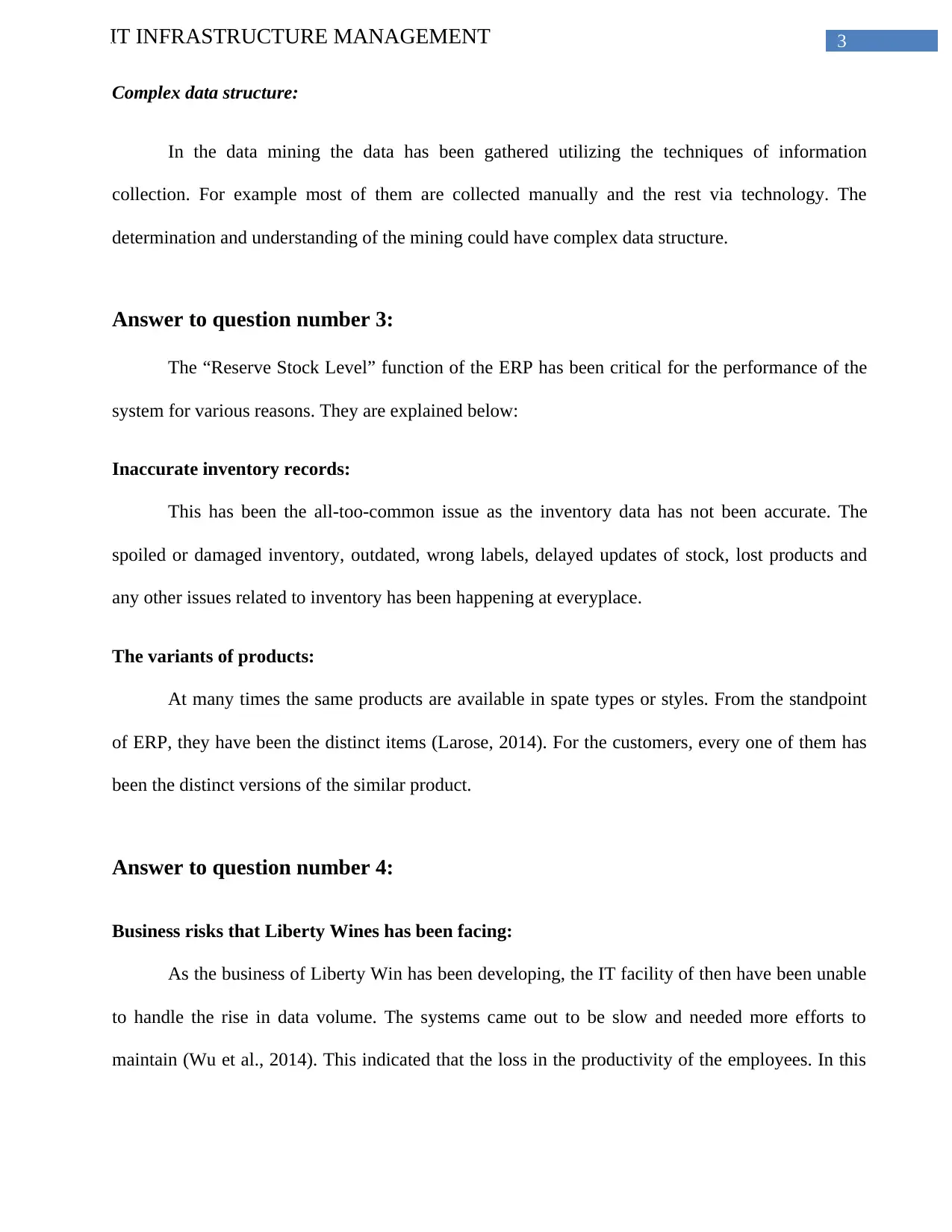
3IT INFRASTRUCTURE MANAGEMENT
Complex data structure:
In the data mining the data has been gathered utilizing the techniques of information
collection. For example most of them are collected manually and the rest via technology. The
determination and understanding of the mining could have complex data structure.
Answer to question number 3:
The “Reserve Stock Level” function of the ERP has been critical for the performance of the
system for various reasons. They are explained below:
Inaccurate inventory records:
This has been the all-too-common issue as the inventory data has not been accurate. The
spoiled or damaged inventory, outdated, wrong labels, delayed updates of stock, lost products and
any other issues related to inventory has been happening at everyplace.
The variants of products:
At many times the same products are available in spate types or styles. From the standpoint
of ERP, they have been the distinct items (Larose, 2014). For the customers, every one of them has
been the distinct versions of the similar product.
Answer to question number 4:
Business risks that Liberty Wines has been facing:
As the business of Liberty Win has been developing, the IT facility of then have been unable
to handle the rise in data volume. The systems came out to be slow and needed more efforts to
maintain (Wu et al., 2014). This indicated that the loss in the productivity of the employees. In this
Complex data structure:
In the data mining the data has been gathered utilizing the techniques of information
collection. For example most of them are collected manually and the rest via technology. The
determination and understanding of the mining could have complex data structure.
Answer to question number 3:
The “Reserve Stock Level” function of the ERP has been critical for the performance of the
system for various reasons. They are explained below:
Inaccurate inventory records:
This has been the all-too-common issue as the inventory data has not been accurate. The
spoiled or damaged inventory, outdated, wrong labels, delayed updates of stock, lost products and
any other issues related to inventory has been happening at everyplace.
The variants of products:
At many times the same products are available in spate types or styles. From the standpoint
of ERP, they have been the distinct items (Larose, 2014). For the customers, every one of them has
been the distinct versions of the similar product.
Answer to question number 4:
Business risks that Liberty Wines has been facing:
As the business of Liberty Win has been developing, the IT facility of then have been unable
to handle the rise in data volume. The systems came out to be slow and needed more efforts to
maintain (Wu et al., 2014). This indicated that the loss in the productivity of the employees. In this
Secure Best Marks with AI Grader
Need help grading? Try our AI Grader for instant feedback on your assignments.
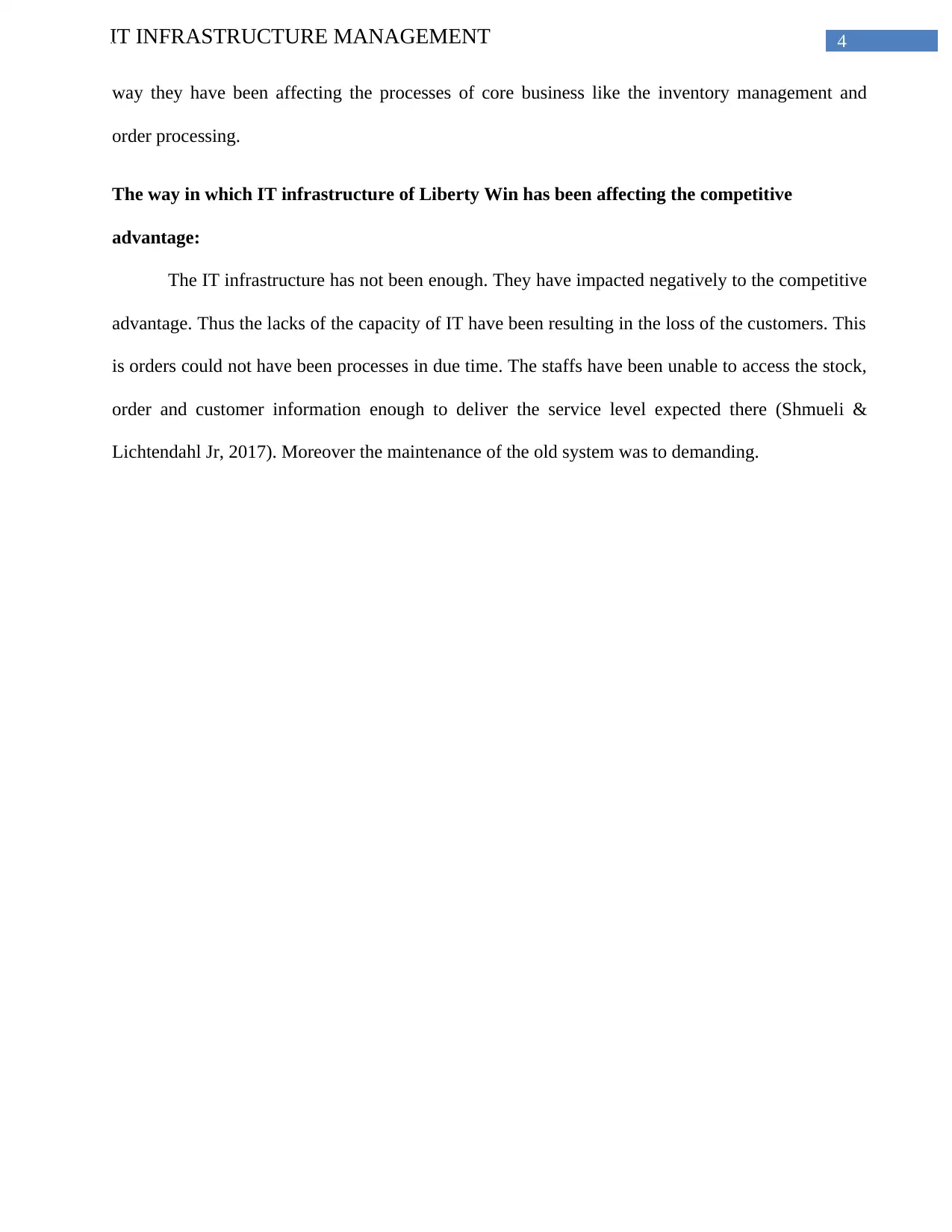
4IT INFRASTRUCTURE MANAGEMENT
way they have been affecting the processes of core business like the inventory management and
order processing.
The way in which IT infrastructure of Liberty Win has been affecting the competitive
advantage:
The IT infrastructure has not been enough. They have impacted negatively to the competitive
advantage. Thus the lacks of the capacity of IT have been resulting in the loss of the customers. This
is orders could not have been processes in due time. The staffs have been unable to access the stock,
order and customer information enough to deliver the service level expected there (Shmueli &
Lichtendahl Jr, 2017). Moreover the maintenance of the old system was to demanding.
way they have been affecting the processes of core business like the inventory management and
order processing.
The way in which IT infrastructure of Liberty Win has been affecting the competitive
advantage:
The IT infrastructure has not been enough. They have impacted negatively to the competitive
advantage. Thus the lacks of the capacity of IT have been resulting in the loss of the customers. This
is orders could not have been processes in due time. The staffs have been unable to access the stock,
order and customer information enough to deliver the service level expected there (Shmueli &
Lichtendahl Jr, 2017). Moreover the maintenance of the old system was to demanding.
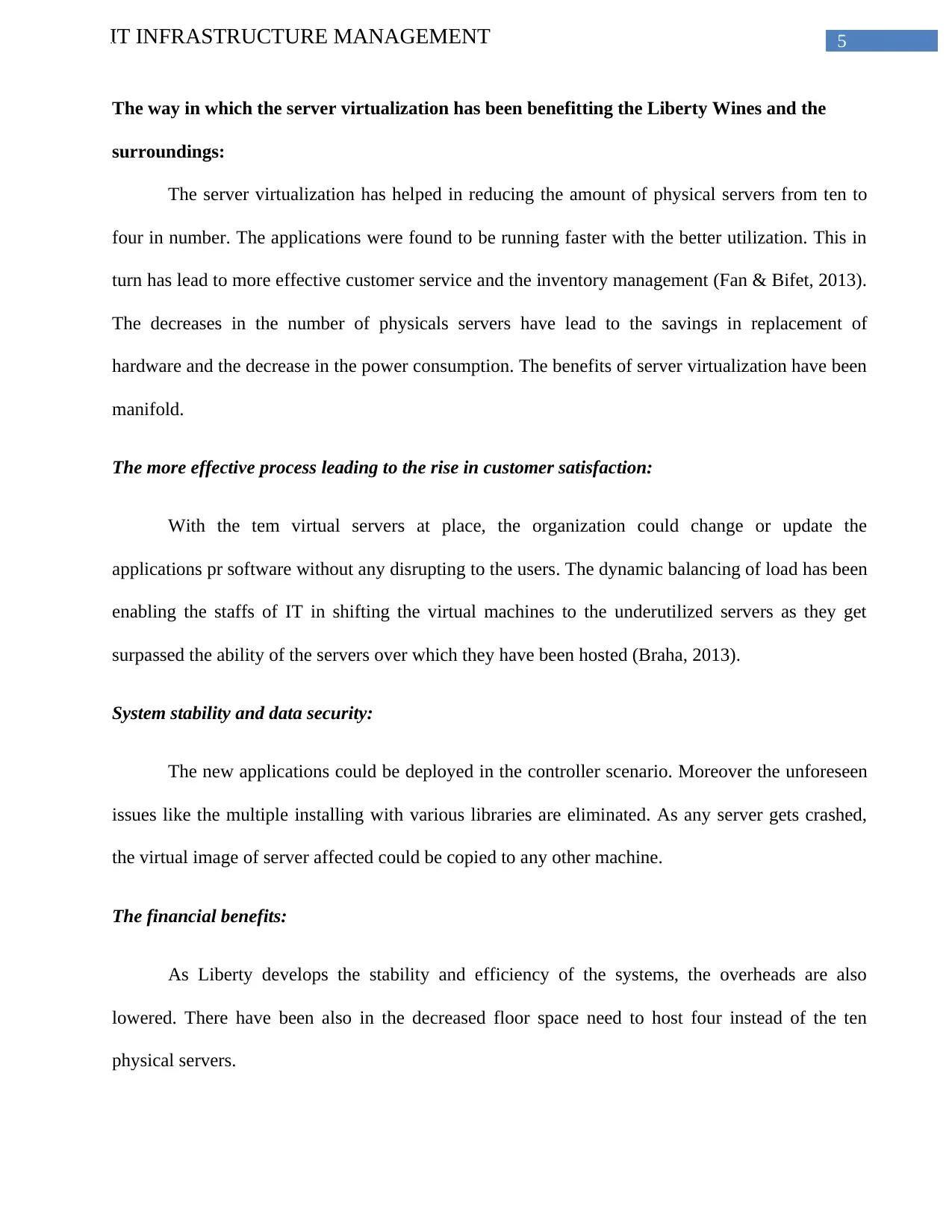
5IT INFRASTRUCTURE MANAGEMENT
The way in which the server virtualization has been benefitting the Liberty Wines and the
surroundings:
The server virtualization has helped in reducing the amount of physical servers from ten to
four in number. The applications were found to be running faster with the better utilization. This in
turn has lead to more effective customer service and the inventory management (Fan & Bifet, 2013).
The decreases in the number of physicals servers have lead to the savings in replacement of
hardware and the decrease in the power consumption. The benefits of server virtualization have been
manifold.
The more effective process leading to the rise in customer satisfaction:
With the tem virtual servers at place, the organization could change or update the
applications pr software without any disrupting to the users. The dynamic balancing of load has been
enabling the staffs of IT in shifting the virtual machines to the underutilized servers as they get
surpassed the ability of the servers over which they have been hosted (Braha, 2013).
System stability and data security:
The new applications could be deployed in the controller scenario. Moreover the unforeseen
issues like the multiple installing with various libraries are eliminated. As any server gets crashed,
the virtual image of server affected could be copied to any other machine.
The financial benefits:
As Liberty develops the stability and efficiency of the systems, the overheads are also
lowered. There have been also in the decreased floor space need to host four instead of the ten
physical servers.
The way in which the server virtualization has been benefitting the Liberty Wines and the
surroundings:
The server virtualization has helped in reducing the amount of physical servers from ten to
four in number. The applications were found to be running faster with the better utilization. This in
turn has lead to more effective customer service and the inventory management (Fan & Bifet, 2013).
The decreases in the number of physicals servers have lead to the savings in replacement of
hardware and the decrease in the power consumption. The benefits of server virtualization have been
manifold.
The more effective process leading to the rise in customer satisfaction:
With the tem virtual servers at place, the organization could change or update the
applications pr software without any disrupting to the users. The dynamic balancing of load has been
enabling the staffs of IT in shifting the virtual machines to the underutilized servers as they get
surpassed the ability of the servers over which they have been hosted (Braha, 2013).
System stability and data security:
The new applications could be deployed in the controller scenario. Moreover the unforeseen
issues like the multiple installing with various libraries are eliminated. As any server gets crashed,
the virtual image of server affected could be copied to any other machine.
The financial benefits:
As Liberty develops the stability and efficiency of the systems, the overheads are also
lowered. There have been also in the decreased floor space need to host four instead of the ten
physical servers.

6IT INFRASTRUCTURE MANAGEMENT
Paraphrase This Document
Need a fresh take? Get an instant paraphrase of this document with our AI Paraphraser
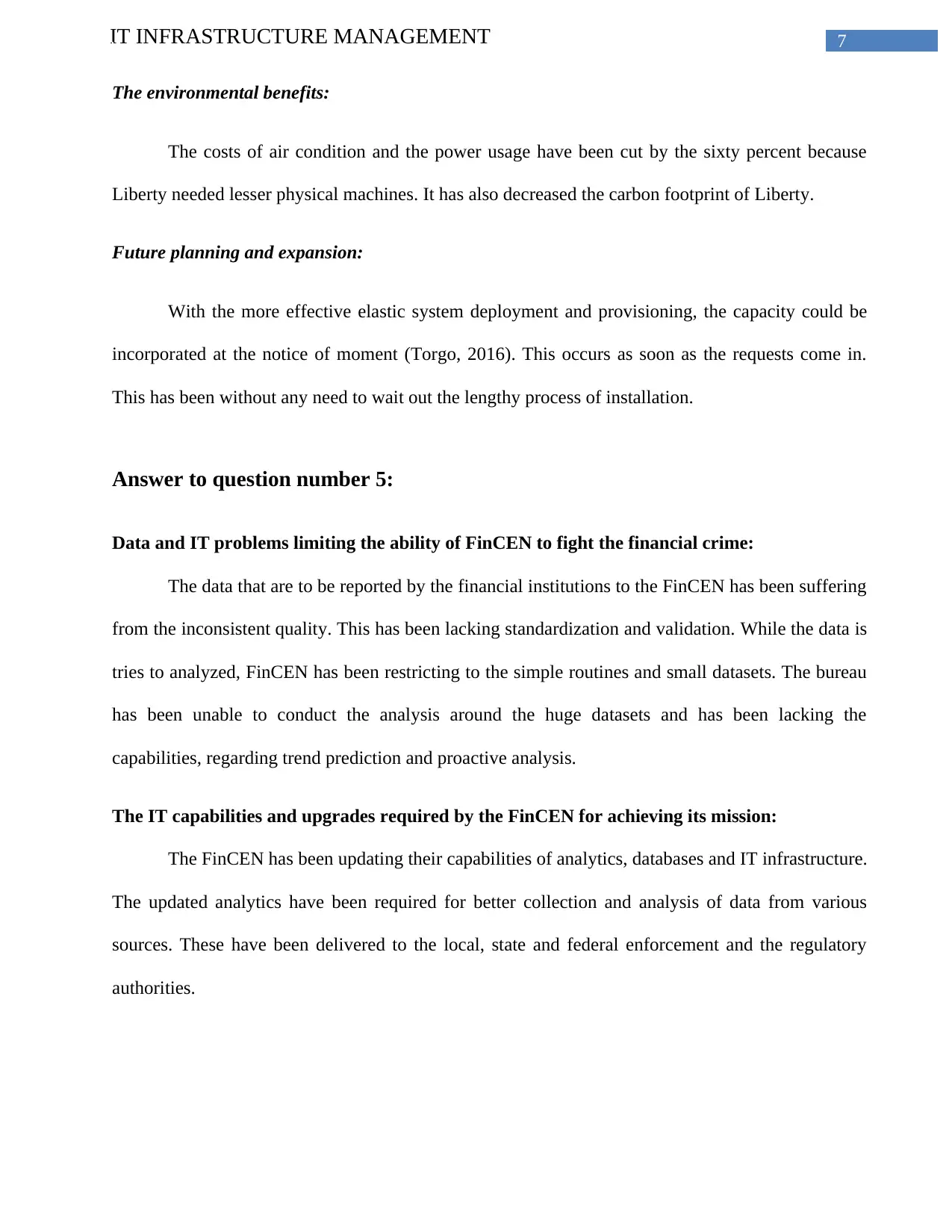
7IT INFRASTRUCTURE MANAGEMENT
The environmental benefits:
The costs of air condition and the power usage have been cut by the sixty percent because
Liberty needed lesser physical machines. It has also decreased the carbon footprint of Liberty.
Future planning and expansion:
With the more effective elastic system deployment and provisioning, the capacity could be
incorporated at the notice of moment (Torgo, 2016). This occurs as soon as the requests come in.
This has been without any need to wait out the lengthy process of installation.
Answer to question number 5:
Data and IT problems limiting the ability of FinCEN to fight the financial crime:
The data that are to be reported by the financial institutions to the FinCEN has been suffering
from the inconsistent quality. This has been lacking standardization and validation. While the data is
tries to analyzed, FinCEN has been restricting to the simple routines and small datasets. The bureau
has been unable to conduct the analysis around the huge datasets and has been lacking the
capabilities, regarding trend prediction and proactive analysis.
The IT capabilities and upgrades required by the FinCEN for achieving its mission:
The FinCEN has been updating their capabilities of analytics, databases and IT infrastructure.
The updated analytics have been required for better collection and analysis of data from various
sources. These have been delivered to the local, state and federal enforcement and the regulatory
authorities.
The environmental benefits:
The costs of air condition and the power usage have been cut by the sixty percent because
Liberty needed lesser physical machines. It has also decreased the carbon footprint of Liberty.
Future planning and expansion:
With the more effective elastic system deployment and provisioning, the capacity could be
incorporated at the notice of moment (Torgo, 2016). This occurs as soon as the requests come in.
This has been without any need to wait out the lengthy process of installation.
Answer to question number 5:
Data and IT problems limiting the ability of FinCEN to fight the financial crime:
The data that are to be reported by the financial institutions to the FinCEN has been suffering
from the inconsistent quality. This has been lacking standardization and validation. While the data is
tries to analyzed, FinCEN has been restricting to the simple routines and small datasets. The bureau
has been unable to conduct the analysis around the huge datasets and has been lacking the
capabilities, regarding trend prediction and proactive analysis.
The IT capabilities and upgrades required by the FinCEN for achieving its mission:
The FinCEN has been updating their capabilities of analytics, databases and IT infrastructure.
The updated analytics have been required for better collection and analysis of data from various
sources. These have been delivered to the local, state and federal enforcement and the regulatory
authorities.
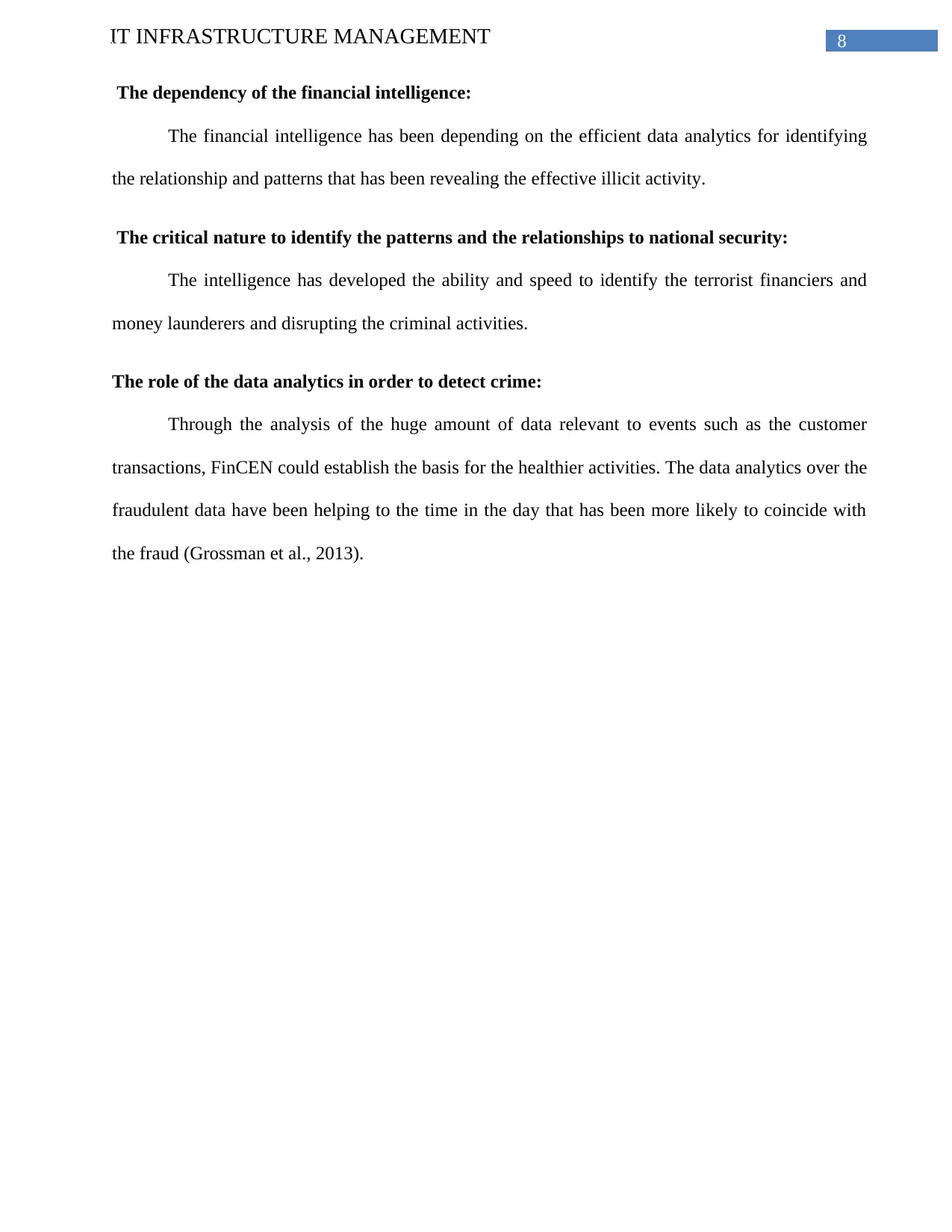
8IT INFRASTRUCTURE MANAGEMENT
The dependency of the financial intelligence:
The financial intelligence has been depending on the efficient data analytics for identifying
the relationship and patterns that has been revealing the effective illicit activity.
The critical nature to identify the patterns and the relationships to national security:
The intelligence has developed the ability and speed to identify the terrorist financiers and
money launderers and disrupting the criminal activities.
The role of the data analytics in order to detect crime:
Through the analysis of the huge amount of data relevant to events such as the customer
transactions, FinCEN could establish the basis for the healthier activities. The data analytics over the
fraudulent data have been helping to the time in the day that has been more likely to coincide with
the fraud (Grossman et al., 2013).
The dependency of the financial intelligence:
The financial intelligence has been depending on the efficient data analytics for identifying
the relationship and patterns that has been revealing the effective illicit activity.
The critical nature to identify the patterns and the relationships to national security:
The intelligence has developed the ability and speed to identify the terrorist financiers and
money launderers and disrupting the criminal activities.
The role of the data analytics in order to detect crime:
Through the analysis of the huge amount of data relevant to events such as the customer
transactions, FinCEN could establish the basis for the healthier activities. The data analytics over the
fraudulent data have been helping to the time in the day that has been more likely to coincide with
the fraud (Grossman et al., 2013).
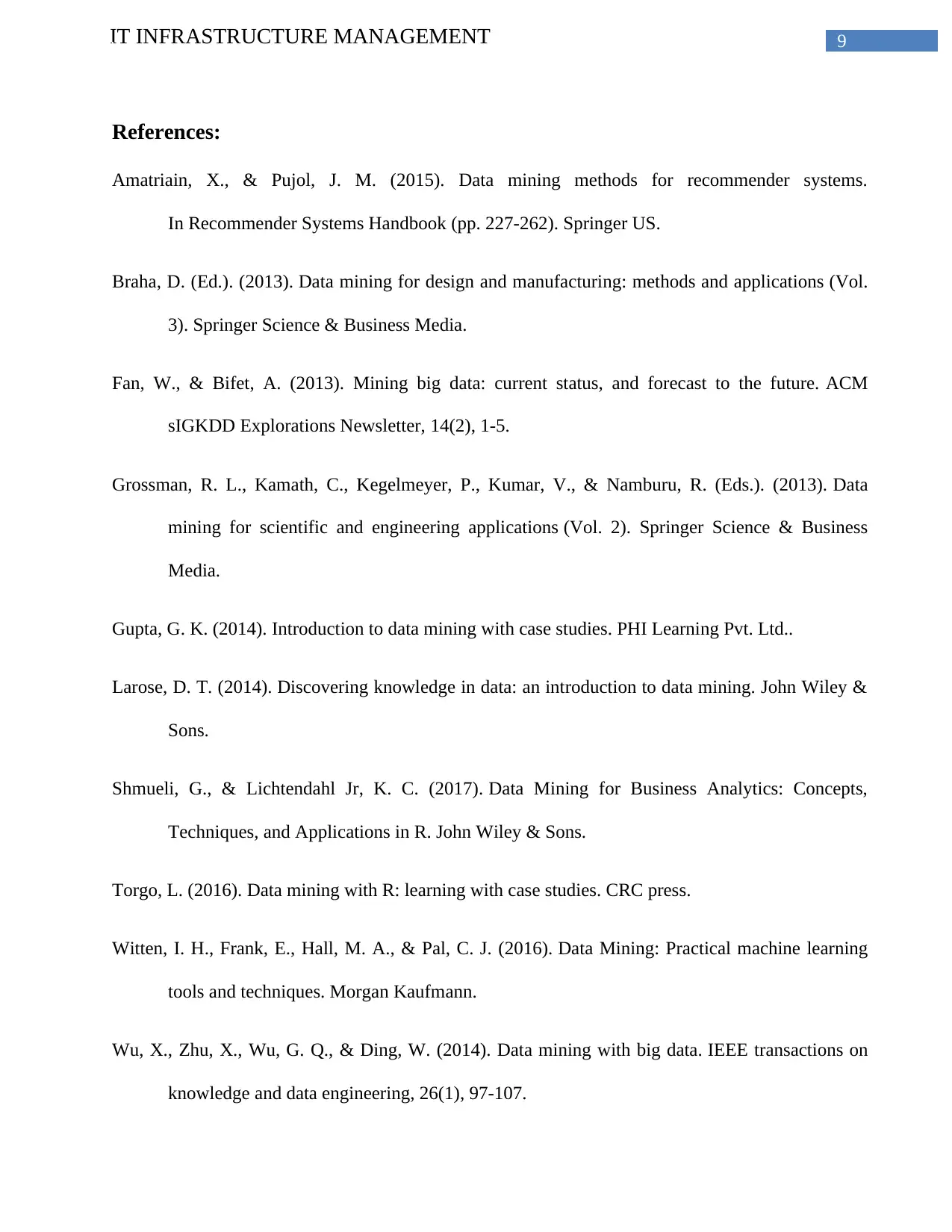
9IT INFRASTRUCTURE MANAGEMENT
References:
Amatriain, X., & Pujol, J. M. (2015). Data mining methods for recommender systems.
In Recommender Systems Handbook (pp. 227-262). Springer US.
Braha, D. (Ed.). (2013). Data mining for design and manufacturing: methods and applications (Vol.
3). Springer Science & Business Media.
Fan, W., & Bifet, A. (2013). Mining big data: current status, and forecast to the future. ACM
sIGKDD Explorations Newsletter, 14(2), 1-5.
Grossman, R. L., Kamath, C., Kegelmeyer, P., Kumar, V., & Namburu, R. (Eds.). (2013). Data
mining for scientific and engineering applications (Vol. 2). Springer Science & Business
Media.
Gupta, G. K. (2014). Introduction to data mining with case studies. PHI Learning Pvt. Ltd..
Larose, D. T. (2014). Discovering knowledge in data: an introduction to data mining. John Wiley &
Sons.
Shmueli, G., & Lichtendahl Jr, K. C. (2017). Data Mining for Business Analytics: Concepts,
Techniques, and Applications in R. John Wiley & Sons.
Torgo, L. (2016). Data mining with R: learning with case studies. CRC press.
Witten, I. H., Frank, E., Hall, M. A., & Pal, C. J. (2016). Data Mining: Practical machine learning
tools and techniques. Morgan Kaufmann.
Wu, X., Zhu, X., Wu, G. Q., & Ding, W. (2014). Data mining with big data. IEEE transactions on
knowledge and data engineering, 26(1), 97-107.
References:
Amatriain, X., & Pujol, J. M. (2015). Data mining methods for recommender systems.
In Recommender Systems Handbook (pp. 227-262). Springer US.
Braha, D. (Ed.). (2013). Data mining for design and manufacturing: methods and applications (Vol.
3). Springer Science & Business Media.
Fan, W., & Bifet, A. (2013). Mining big data: current status, and forecast to the future. ACM
sIGKDD Explorations Newsletter, 14(2), 1-5.
Grossman, R. L., Kamath, C., Kegelmeyer, P., Kumar, V., & Namburu, R. (Eds.). (2013). Data
mining for scientific and engineering applications (Vol. 2). Springer Science & Business
Media.
Gupta, G. K. (2014). Introduction to data mining with case studies. PHI Learning Pvt. Ltd..
Larose, D. T. (2014). Discovering knowledge in data: an introduction to data mining. John Wiley &
Sons.
Shmueli, G., & Lichtendahl Jr, K. C. (2017). Data Mining for Business Analytics: Concepts,
Techniques, and Applications in R. John Wiley & Sons.
Torgo, L. (2016). Data mining with R: learning with case studies. CRC press.
Witten, I. H., Frank, E., Hall, M. A., & Pal, C. J. (2016). Data Mining: Practical machine learning
tools and techniques. Morgan Kaufmann.
Wu, X., Zhu, X., Wu, G. Q., & Ding, W. (2014). Data mining with big data. IEEE transactions on
knowledge and data engineering, 26(1), 97-107.
1 out of 10
Related Documents
Your All-in-One AI-Powered Toolkit for Academic Success.
+13062052269
info@desklib.com
Available 24*7 on WhatsApp / Email
![[object Object]](/_next/static/media/star-bottom.7253800d.svg)
Unlock your academic potential
© 2024 | Zucol Services PVT LTD | All rights reserved.





